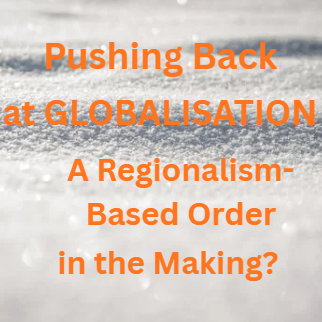– Usman Khan Pathan
Globalisation, as a modern political and economic phenomenon, gained significant momentum after the wave of decolonisation in the mid-20th century. With the collapse of colonial empires in Asia, Africa, and the Middle East, newly independent states were left with fragile and often “rigged economies” dependent on raw material exports, weak industrial bases, and poor infrastructure. To revive their economies and integrate into the international order, many looked outward. Globalisation, defined as the increasing interconnectedness of economies, societies, and cultures across national borders, appeared to offer a way forward.
The foundations of globalisation were laid earlier, through the creation of the Bretton Woods institutions in 1944 – the International Monetary Fund (IMF) and the World Bank, along with the General Agreement on Tariffs and Trade (GATT) in 1947, later replaced by the World Trade Organisation (WTO) in 1995. These institutions promoted economic liberalisation, development loans, and freer trade. But globalisation as a political slogan and deliberate economic strategy took centre stage in the 1980s, driven by two towering Western leaders: Ronald Reagan and Margaret Thatcher.
Thatcher, Reagan, and the Neoliberal Push (1979–1989)
Margaret Thatcher, who became Prime Minister of the United Kingdom in May 1979, and Ronald Reagan, inaugurated as President of the United States in January 1981, spearheaded a new global economic order. Their policies – later branded “Thatcherism” and “Reaganomics” – rested on three pillars: deregulation, privatisation, and liberalisation.
Thatcher declared in 1981: “There is no alternative” (TINA) to free markets. Similarly, Reagan in 1986 said: “We who live in free market societies believe that growth, prosperity, and human fulfilment are created from the bottom up, not the government down.” Both leaders believed globalisation, through free trade and open markets, was the path to growth.
They actively pushed globalisation not only at home but abroad as well. Reagan strongly backed the Uruguay Round of GATT negotiations (1986-1994), which paved the way for the creation of the WTO. Thatcher promoted the European Single Market project of 1986, ensuring free movement of goods, services, people, and capital across Europe.
Globalisation promised what the post-colonial world desperately needed – foreign investment, access to international markets, and economic modernisation. By the 1990s, with the end of the Cold War and the collapse of the Soviet Union (1991), globalisation became the dominant global paradigm. World leaders like Bill Clinton and Tony Blair framed globalisation as not just economic inevitability, but also a moral project. Clinton said in 2000: “Globalisation is not something we can hold off or turn off. It is the economic equivalent of a force of nature – like wind or water.”
Globalisation’s Achievements (1990s-2000s)
By the early 2000s, globalisation had indeed reshaped the world:
- Global trade increased from 39% of world GDP in 1990 to 61% by 2008 (World Bank data).
- China’s entry into the WTO in 2001 transformed it into the “factory of the world.”
- The European Union expanded eastward (2004, 2007), integrating post-Communist states.
- The rise of multinational corporations (MNCs) and global supply chains made economies deeply interdependent.
The world was more interconnected than ever before. Thomas Friedman’s 2005 book “The World is Flat” captured the optimism of this era, arguing that globalisation had levelled the playing field.
But beneath this triumphalist narrative, critics like Joseph Stiglitz (“Globalisation and Its Discontents,” 2002) and Dani Rodrik (“Has Globalisation Gone Too Far?”, 1997) warned that globalisation was unequal, destabilising, and prone to political backlash.
The Pushback: Regionalism and Protectionism (2010s-2020s)
By the 2010s, globalisation began facing strong headwinds – ironically from the very states that once championed it.
- Brexit (2016): The United Kingdom voted to leave the European Union after decades of being one of its main architects. Brexit was fuelled by nationalist sentiments, immigration fears, and a desire to reclaim “”
- Trump’s America First (2016-2020): U.S. President Donald Trump imposed tariffs on Chinese goods in 2018, igniting a trade war. He withdrew the U.S. from the Trans-Pacific Partnership (TPP) and renegotiated NAFTA into USMCA. His slogan, “Make America Great Again”, was essentially a rejection of globalisation in favour of national protectionism.
- Rise of Deportations & Anti-Immigration Policies: From Europe’s tightening asylum rules to U.S. deportations, the free movement of people – once a pillar of globalisation – faced severe curbs.
- COVID-19 Pandemic (2020): Global supply chains collapsed, and states closed borders, prioritising national stockpiles of medicines, vaccines, and essentials. This shattered the idea of a smoothly interconnected world.
- Russia-Ukraine War (2022): The conflict triggered unprecedented sanctions, with the U.S. and Europe weaponizing finance (SWIFT exclusion, dollar dominance). Meanwhile, Russia pivoted trade towards China and India, underscoring regional alignments.
Globalisation’s Hypocrisy? Gaza and the Failure of Global Institutions
The continuing genocide in Gaza (2023-2024), with the United States shielding Israel from censure in the UN Security Council, raises questions about the credibility of international institutions. The very institutions globalisation had elevated – the UN, WTO, IMF – appear ineffective or biased when Western interests are at stake.
As political economist Immanuel Wallerstein argued, globalisation has always reflected the interests of the world-system’s core powers. The Gaza crisis demonstrates how Western states defend sovereignty at home, while undermining it elsewhere, exposing globalisation as less about universalism and more about power asymmetry.
Case Study: India in the Globalised Order
India’s experience illustrates globalisation’s contradictions. In a globalised economy, India should be free to trade with partners of its choice. Yet, its decision to buy discounted Russian oil since 2022 has invited U.S. displeasure. India faces tariffs on exports – notably steel and aluminium – and pressure to align with Western sanctions. This reveals that globalisation is not truly borderless; it is policed by powerful states.
The Emergence of a Regionalised Order
Today, globalisation is not disappearing but mutating into regionalised globalisation:
- The U.S. and its allies form one bloc, privileging each other through security and trade agreements.
- China’s Belt and Road Initiative (2013–present) has created another economic sphere.
- Regional trade pacts like RCEP (2020, led by ASEAN + China) and AfCFTA (African Continental Free Trade Area, 2018) show the rise of regional self-reliance.
Political scientist Andrew Gamble calls this “the return of economic nationalism,” while others speak of “slowbalization” – the slowing and fragmentation of globalisation.
Complex Globalisation, Not Its End
Are we in a post-globalisation world? Perhaps not entirely. What we see today is complex globalisation – an interconnected world marked by fragmentation, power asymmetries, and regional blocs.
Globalisation, once hailed as a universal force of integration, is now fractured along political, economic, and ideological lines. States must navigate this reality with unorthodox realpolitik, balancing sovereignty with economic compromises.
As Dani Rodrik writes: “We cannot simultaneously pursue democracy, national determination, and economic globalisation. We must choose two of the three.” The world seems to be choosing sovereignty and regionalism, even if it comes at the cost of a truly global order.




